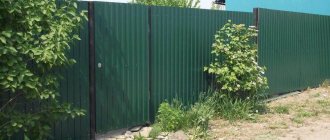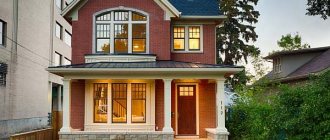Layout
Anastasia Zemlyanichko 02/20/2018 no comments
0
( 17 ratings, average: 4.41 out of 5)
- 1 How to determine distance
- 2 From the road
- 3 Distance to neighboring site
- 4 Distance from outbuildings
- 5 Distance between buildings on the site
- 6 Construction of a bathhouse
- 7 Documentation
When creating a private house project, many parameters are taken into account. The comfort of housing depends on them. Special norms have been developed, which do not make sense to violate in order to avoid unnecessary fines from various services. And you shouldn’t spoil relations with your neighbors.
One of the main characteristics when drawing up project documentation is the distance from the house to the fence. The issue of borders is quite controversial. Sometimes it has to be resolved through the courts.
From the side of the road
Often the land plot borders the roadway. A fence with the main gate is placed on this side. A short distance from the house to the fence can have both positive and negative effects:
- the smaller the space from the house to the fence, the closer the gate, which is convenient in inclement weather;
- if the house is next to the road, road noise will be heard in it;
- a close border will not protect household members from prying eyes through the windows.
How many meters should be from the road?
SNiP rules establish a minimum distance from the house to the road of 5 meters. It is possible to increase the interval, but it is not advisable to decrease it. 5 meters is the optimal distance for the convenience of residents. And there will be no problems with coordination.
Rules and regulations for the construction of a private house from neighbors
- for smaller outbuildings compared to the house, the indentation can be made from 1 meter;
- the construction of utility structures for raising small livestock or poultry can be carried out at least 4 meters from the boundary fence;
- the distance from the compost pit or street toilet must be at least 8 meters in a straight line.
- Between houses of 1st and 2nd degree of fire resistance (concrete, brick, foam concrete, sandstone) there should be at least 6 meters.
- If at least one of the houses belongs to the 3rd degree of fire resistance (a metal or concrete frame with fire-protected ceilings and walls), then the distance between them is 8 meters.
- If a wooden house is being built or there is one on a neighbor’s property, the distance between them must be at least 15 meters. Such structures are very fire hazardous, so strict recommendations on location on the site are also applied to the construction of bathhouses. These are exactly the buildings that cannot be placed close to anything, especially anything highly flammable.
Distance to neighboring site
This distance is usually a subject of debate and misunderstanding . This is especially true for multi-storey cottages. Such buildings shield part of the adjacent area from sunlight, which prevents the growth of any plants.
If you build a house in the center of the plot, it will harm your own garden. In some areas it is impossible to maintain the distance between buildings according to SNiP standards. The standards for the construction of a private house from neighbors determine the distance between two buildings to be 11 meters.
Nevertheless, in practice in the village they take the distance to the boundary as 3 meters . This is the minimum distance from the house to the property line to prevent fire. If it is complied with, neighbors cannot go to court.
Before implementing a building project, you should consult with BTI employees. They can advise on the optimal location of the house and the fence to it, so that in the future there will be no problems with the approval of documents. This also applies to country houses.
Don't forget about the human factor. To avoid conflicts with neighbors in the private sector, you can draw up a written conclusion with them in advance. This document will help avoid conflicts when changing neighbors.
How many meters should there be from the fence to the house according to standards?
A distance of 5 m is most often recommended by local administrative authorities and SNiP, and is also the most optimal. In recent years, it has become fashionable to build private houses of 2-3 or more floors. Such a building, if located close to a neighboring house or site, will cause them to be shaded. And if a tall building is placed in the middle, it can harm your garden and garden.
In order to save territory, homeowners often take into account only the distance from the building to the fence and foundation, omitting the porch, stairs and other extensions in relation to the fence when calculating. As a result, after finishing the construction of the house and all the parts attached to the house, it turns out that they are located crowded and inconveniently. Moreover, the precipitation that flows from the roof of your house ends up on the neighboring plot, washing away the soil. It's unlikely that anyone will like this.
We recommend reading: General Disease Disability Group 2 List of Diseases
Distance from outbuildings
When constructing various domestic buildings, owners of private houses usually do not attach importance to the minimum distance to the fence . But such an approach can cause a lot of controversy and disagreement.
The distance to the fence from buildings according to GOST must be at least 1 meter. For example, the distance from the bathhouse.
If you enter into an agreement with the owner of the neighboring plot, you can build at a shorter distance. However, in this case, fire safety requirements will be violated. Some neighbors even demand money for such outbuildings.
According to the standards, the distance from the fence to buildings with pets and birds must be at least 4 meters .
The same distance is provided for trees of considerable height. For shrubs this interval is 1 meter .
According to the rules, the fence structure between neighboring areas cannot be solid or higher than 1.5 m . You can separate the area from the roadway with a continuous high fence.
If you agree with your neighbors on a different fence height, this agreement should be formalized in writing. In this case, the agreement will have legal value and importance in court.
SNiP requirements often give way to local laws and rules of certain gardening associations and municipalities. After all, SNiPs are just norms, not laws . And legislative issues are indicated by the relevant documents of each specific locality.
For example, the authorities of the Volgograd region allow the construction of fences no more than 2.2 m. Their transparency is no less than 50% of the entire fence area. An opaque fence should have a height of no more than 0.75 meters.
These standards apply to cottage construction. Therefore, before building fences, it is advisable to pay a visit to the local administration to find out how high the structure can be built.
Distance between fence and buildings
Between the fence and all buildings in neighboring areas, the distances approved in SNiP must be observed. It is necessary to understand that these are forced measures and each parameter is determined by specific factors. For example, there must be a space of at least 3 m between the house and the fence. The reason is the arrangement of a blind area from the house, which will not be possible if the fence is adjacent closely. In addition, fire and technical safety factors are important.
You also need to know one more tightening. If a porch, canopy, roof slope, wall fragment and any other architectural forms protrude from the overall structure of the building by more than 50 cm, then all specified distances are calculated from them. In addition, even if you step back 1 meter from the boundary, when erecting the slope of the barn roof, you must direct it in your direction. These standards apply equally to buildings in both adjacent territories.
In any case, the legislative documents that regulate the installation of fences between areas call for common sense. They are advisory in nature, but the rules of cohabitation should be understood and followed. After all, you need to live peacefully with your neighbors and not argue even over the most expensive fence - it’s not worth it.
Construction of a bathhouse
The bathhouse can be built from different materials: wood, brick, with a drainage pit or with a ditch. All these nuances determine at what distance from the fence you can build a bathhouse.
SNiP standards define this distance as 3 meters . This matters to the neighbors. The sauna structure should not shade the neighboring area, nor should it pose a fire hazard.
The distance also depends on the drainage system. If water flows into a ditch, the puddle is unlikely to suit the neighbors. A distance of 3 meters will protect neighbors from unnecessary puddles. If you equip a pit with a high-quality drainage structure, you can save some distance.
The distance from the house to the bathhouse should be more than 0.8 m . If the bathhouse is made of brick or concrete, you can move the border towards the fence. The bathhouse from the neighbor's house can be located at a distance of 0.6 meters.
If a bathhouse is being built on a summer cottage, the distance from it to the fence is 0.3 m or 0.25 m. But at the same time, an interval of one meter must also be maintained between other outbuildings.
cannot be closer than 8 meters to a residential building ; for a brick bathhouse this parameter is 6 meters. Counted from the protruding part of the home.
If a neighbor has built a bathhouse too close, you can demand that it be moved. Of course, you should not expect that the requirement will be fulfilled quickly and unconditionally. After all, the construction process is not a cheap pleasure. To insist on your own, you can go to court. But it is not a fact that the court will decide the issue of moving the bathhouse. Perhaps the case will only end with a fine.
Distance from the building to the neighbors' fence
Housing that constitutes the private sector is always subject to additional architectural vetoes imposed by the state. Where neighbors live nearby, it is necessary to take into account the number and size of existing buildings. The minimum distance between structures is determined by the materials of the structures, the presence of vegetation, and other materials. There are also additional features:
- The distance between the new cottage and existing wooden buildings should be 15 meters, stone, concrete, brick buildings - 10 meters.
- The neighboring buildings are made of concrete or brick, but the structures contain wooden floors, then a distance of less than 8 meters is considered unacceptable.
- Buildings made of non-combustible materials are located closest, a distance of more than 6 meters.
- Buildings with a height of 2-3 floors should be located at a safe distance of 15 meters.
Another thing is objects inside a private plot. The location, distance of which is not strictly regulated, because SNiP standards are aimed at regulating developments in entire areas, groups of areas.
Documentation
The process of paperwork is a very serious stage that should not be ignored. There are two registration methods:
- obtaining consent from neighbors and approval from the BTI. Next they build a house. The finished building is formalized through the court;
- Having collected all the permits and made the project, they agree on it. After construction, an act of acceptance and commissioning of the object is drawn up, which is registered in the BTI.
The second method is considered more correct.
Before starting construction, you must obtain all the necessary documents. First of all, this is a building permit. Having received permission, the developer can begin construction work. To obtain permission, you should contact your local administration or architectural department. List of documents for obtaining permission:
- statement;
- document confirming ownership;
- site layout diagram;
- cadastral passport;
- passport details.
After receiving permission, the developer provides data on the number of storeys of the building, design and technical documents.
The final step is to obtain ownership of the house . This is usually done at the Rosreestr branch.
Rules and regulations may change. The key to successful construction and the absence of problems in the future can be good relations with neighbors and local administration.
0
( 17 ratings, average: 4.41 out of 5)
Back
A virtual exhibition of Architecture and Interior Design will be held from February 20 to March 20
MORE
How high should the fence be?
Not long ago my brother bought an apartment in some kind of clubhouse . Everything is basically good, there are only three floors and there is an apartment on each floor. The area of the house was surrounded by a high, blank fence approximately 2.5 meters high. On this territory there is a parking lot and a small “green area”. But not so long ago, a neighbor “in court” forced the height of this fence to be cut, and it was reduced significantly. "How? Why?" - you can ask. But the law tells us something else, so when building, be sure to inquire about the maximum height of the fence, today I will try to explain everything simply and clearly...
- The fence between neighboring areas should be a maximum height of 1.5 meters. Also, it should not be continuous, that is, it should be made of chain-link mesh, picket fence (both wooden and plastic - metal), grating or other options, so that the clearance remains approximately 50%. That is, there must be gaps between the material.
We recommend reading: Section of an apartment in a mortgage
Requirements for the fence itself
The distance from the fence to the house is fixed by SNiP rules. But it’s not just the footage that matters. All residential and non-residential premises must be made of specific materials. There are special legal requirements for the fences themselves. Thus, the following requirements for external fences must be taken into account:
- the maximum height cannot exceed 2 meters;
- minimum transparency – 50%.
These new standards are advisory, so property owners can independently adjust the height and transparency of the fence. The city administration will not make any claims until the neighbors start complaining about the fence.
As for fencing at the boundary with neighboring yards, in 2020 the following factors will have to be taken into account:
- the fence cannot be higher than 170 cm;
- It is better if transparency is reduced to zero.
It would seem that no individual problems should arise, but an excessively high fence can create a shadow on the neighbors’ territory.
There are no uniform requirements for what materials fences should be made of; you can use:
- net;
- metal;
- tree;
- profile.
How many meters must be set back from the property line when building a house in the private sector?
Requirements for the placement of buildings and structures exist as part of the implementation of fire safety measures. In accordance with the requirements of clause 4.11 “SP 4.13130.2009. Set of rules. Fire protection systems. Limiting the spread of fire at protection facilities. Requirements for space-planning and structural solutions”, approved by Order of the Ministry of Emergency Situations of the Russian Federation dated March 25, 2009 No. 174, fire distances between buildings, structures and structures of fire resistance degrees I and II can be reduced to 3.5 m, provided that the wall of a higher building, structure and a structure located opposite another building, structure or structure is a Type 1 fire hazard.
In this connection, the answer to your question depends on information regarding the materials from which the buildings are made, as well as information on the height of the buildings located on the neighboring site. If the wall of your garage and the wall of the building located on the neighboring site belong to type 1 walls, then the total distance between them can be 3.5 meters, that is, 1.75 m on each side, or at unequal distances (for example, 1 m and 2.5 m.).
Interesting: Taxes and fees under the GPC agreement
At what distance from the fence should I build a house?
Even at the stage of designing a private house, you need to take into account many parameters and rules for the location of various buildings relative to the fence. Even on your own site, buildings cannot be placed in any order. The rules for installing fences and erecting buildings inside the site are regulated by SNiP. In addition to the requirements of SNiP, local regulations must be taken into account.
It is advisable to comply with the requirements and recommendations of SNiP, because failure to comply may result in a fine or a lawsuit from disgruntled neighbors. And basically, the court decision is not made in favor of the offender.
How many meters should the entrance to a private residential building be?
Roads, driveways and entrances to buildings, structures, structures and water sources used for fire extinguishing purposes must always be free for the passage of fire equipment, kept in good condition, and in winter be cleared of snow and ice. The width of passages for fire equipment must be at least 6 meters. The total width of the fire passage combined with the main entrance to the building may include a sidewalk adjacent to the passage.
Construction norms and rules SNiP 2.07.01-89* “Urban planning. Planning and development of urban and rural settlements" (approved by Decree of the USSR State Construction Committee dated May 16, 1989 N 78) The distance from the edge of the passage to the wall of the building, as a rule, should be 5 - 8 m for buildings up to 10 floors inclusive.
27 Jun 2020 stopurist 394
Share this post
- Related Posts
- Car for large families from the state in 2020
- Benefits for the purchase of housing for families with many children Tver
- Application for change of tax identification number when changing surname
- Is it possible to restore a lost passport at the MFC?
What type of fence is used between neighboring areas
What kind of fence there will be on the front side of the yard, from the street, depends only on the decision of the owners (unless there are special requirements in the charter of the hotel gardening partnership). As for the division between sections, you need to be guided by the standards.
There are various reasons why some people want to hide from neighbors' eyes with the help of a high and monolithic fence, but everyone must take into account its interference for neighbors. Household plots, especially small ones, are in most cases used for growing plants.
Welded mesh fence between adjacent areas
Plantings need sun, so that during the growth period, from March to September, the time of direct sunlight on the plant is at least three hours. Therefore, for fencing between neighboring territories, transparent types of fencing are used:
mesh lattice
, thin
picket fencemetal rods
.
The height of the fence is also regulated by standards: no more than 1.5 meters. But, the charter of an individual gardening partnership can set its own limiting height standards.
If you still want a high and impenetrable fence, as an option, you can agree with your neighbors on joint participation in its construction. But, seal your agreement on paper certified by a notary, because how long your friendship will last is unknown, because the neighbors may change, and the new owners have every right to demand the demolition of the shading structure.
Fence installation rules
Bathhouse, swimming pool, well, summer shower
Although a bathhouse, a swimming pool, a well, a well and a summer shower are, on the contrary, quite clean objects, unlike a toilet and a pit, their location also has its own standards. What distance should be to them?
A bathhouse is not only a place where there is a lot of water, but also a rather dangerous structure, which is most often built of wood. Even after applying all kinds of impregnations and coatings, this material is more flammable than stone or brick. Therefore, between the bathhouse and the fence or boundary there should be at least 1 meter, but to another building - at least 8. Step back so much that there are no complaints against you from the owners of the nearby plot or from the city fire service.
It is recommended to install a stationary pool at least 100 centimeters from the fence. What is the distance from home? 2 meters or more from any building on the site and nearby.
A well is a great idea for a private home. But there must be at least 3 meters between it and the residential building to which the water supply will be installed. Thanks to it, you can become independent from the city water utility, save money on its services and control the quality of water entering your home using filters.
Don’t forget to change filters on time and submit your water for analysis to a sanitary inspection or laboratory! The same advice applies to well water if you use it for drinking and cooking.
Unfortunately, it is not possible to drill a well or well everywhere, since not in every area the aquifer lies high enough. In some places this is simply irrational (you need to drill too deep), in others it is technically impossible. If you have a small plot and have a composting device and an outdoor latrine, then you will not be able to install a well or borehole at all. There must be at least 8 meters between them! But it can be very close to a residential or utility building - 70 cm and further if the diameter is 100 cm.
At first glance, a completely harmless summer shower could be placed anywhere on the site. But in reality he:
- should not get used to living in a residential building;
- there should be at least 1 meter between it and the fence, and 8 meters from any buildings.









